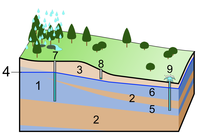
Photo from wikipedia
The present paper aimed at assessing the hydrochemistry and the water quality of the groundwater in the urban area of Baghdad. Sixty-six groundwater samples were collected from shallow tube wells… Click to show full abstract
The present paper aimed at assessing the hydrochemistry and the water quality of the groundwater in the urban area of Baghdad. Sixty-six groundwater samples were collected from shallow tube wells and analyzed for pH, total dissolved solids (TDS), electrical conductivity (EC), calcium, magnesium, sodium, potassium, chloride, bicarbonate, carbonate, sulfate and nitrate. Groundwater suitability for drinking was evaluated based on the World Health Organization (WHO) and Iraqi standards, whereas suitability of groundwater for irrigation was evaluated based on various hydrochemical parameters and methods, such as sodium adsorption ratio (SAR), residual sodium carbonate (RSC), sodium percentage (%Na), United States salinity diagram, Wilcox’s diagram and magnesium hazards (MH). Results showed that the urban area of Baghdad is highly affected by the anthropogenic sources. Based on Piper diagram, the groundwater in the study area are classified into two water types (NaCl and CaCl), indicating high-salinity water. Gibbs ratio indicates that the majority of the groundwater in the study area is affected by the evaporation process. Furthermore, the ion exchange process revealed that 85% of the groundwater samples indicate chloro-alkaline disequilibrium. Moreover, it was found that all the groundwater samples are unsuitable for both drinking and irrigation purposes.
Journal Title: Environmental Processes
Year Published: 2019
Link to full text (if available)
Share on Social Media: Sign Up to like & get
recommendations!